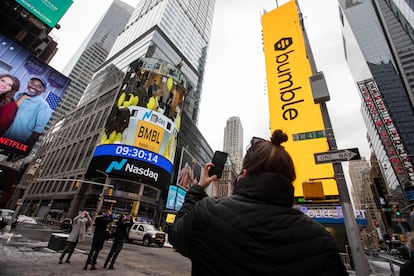Hard times for Tinder and Bumble: Why investors are cashing in their dating app stock
Saturation, a lack of innovation, rising fees, and the resurgence of real-world interactions pose significant threats to the business of hook-up apps


The major dating apps have had their hearts broken; their honeymoon with investors appearing to have come to an end. Two examples illustrate this rupture. The first is Bumble, which promised to give women more power in digital liaisons, stipulating that they be the ones to begin conversations on the app. The U.S. app’s breakout moment culminated when it began trading on the Nasdaq in February 2021. The company’s initial public offering (IPO) made a strong debut, with shares surging 85% on the first day, jumping from $43 to $78.89. However, the stock has since plummeted, now trading at just $6.33 after a 57% decline this year. The second is Match Group, where a similar situation has unfolded. Since its IPO in 2015, Match Group — the dating industry leader that owns platforms like Tinder and Match.com — saw its peak stock price in December 2021, but its shares have since dropped by 79%
Why are investors cashing in their stocks in these companies? Various reports blame the platforms themselves for having raised in-app prices to increase earnings. But in reality, things are more complicated. Tinder has a range of rates, from $3.99 to $499.
“That’s not a huge amount of money, so perhaps the apps’ struggles stem from another issue. “I’m not paying one cent to flirt,” says 26-year-old Paula García, who’s had a Tinder account since she was 18 and has used it to “snag” a couple of stable, two-year relationships. “It’s like a catalog. You’re selling yourself through a menu; it’s like going to a butcher shop — until you try the product, you don’t know if it’s worth the trouble.”
García prefers Bumble, mainly because it gives women more control and even provides icebreaker questions like “What is your life’s dream?” However, she finds it frustrating that users have to pay for increased visibility. “It’s absurd. If you’re unattractive, it won’t help — you’re not going to get anyone. Find another strategy, like being funny,” she says. The sheer volume of choices can also be overwhelming. In just the past week, she’s received 999 matches, all generated by the algorithm. “It can be suffocating,” she admits. A similar pattern occurs on Tinder, where 84% of users are men.
“Gen Z is hesitant to pay for digital dating, largely because they’re young and still frequent places [like bars or schools], where meeting people in person is easy,” says Jess Carbino, a sociologist who studied at UCLA. As they grow older, Carbino suggests they’ll be more inclined to invest in online dating. However, the bigger challenge might be the sheer diversity within this generation, which requires careful market segmentation to connect with them.
García, for instance, foresees a future of “disillusionment” for her peers. In her view, turning 30 marks the start of a decade of loneliness, with fewer singles to meet. “Young people don’t want to commit,” she observes. “Children? That’s still taboo.”
Differing expectations in the dating world have led to a surge of niche apps, each catering to specific needs. For example, those seeking “open relationships” often gravitate toward platforms like Feeld, while single parents turn to Stir, and people of color to BLK or Chispa. All of these platforms are owned by Match Group. According to a report from U.S. bank Jefferies, Match Group’s economic goal is to balance the demographic ecosystems — including men, women, and various age groups — to create platforms that offer suitable matches for everyone.
Grindr, a platform aimed at the gay community, has thrived by connecting deeply with its market niche. Between January and June this year, Grindr’s revenues surged by 34%, reaching $117 million, while its gross operating profit increased by 40% to $68.5 million, driven by its more than 14 million active users.
A competitive space
Meanwhile, Bumble is struggling to hold its ground in an increasingly competitive market, despite a 17.67% rise in paid users over the past year. The company also recently cut 30% of its workforce. Analysts at Jefferies have become increasingly skeptical, slashing earnings estimates and expressing concern about Bumble’s ability to reignite growth. Bank of America experts highlighted the company’s sluggish revenue growth on August 8, noting only a 3% year-on-year increase for the April-June quarter. They forecast a modest revenue for the year at $1 billion, just a 1% rise. Similarly, Match Group’s performance isn’t much stronger. For the same quarter, its revenue grew by only 4%, reaching $3.5 billion.
Despite the challenges, Bumble’s CEO, Lidiane Jones, expressed optimism in an email to EL PAÍS: “We’ve introduced a bold, customer-focused strategy that will help us better align with our ultimate mission of becoming the top global choice for those seeking love, friendship, and community.”
However, the real test lies in execution. Match Group’s Hinge, for example, offers users a list of recommended profiles but charges $3.99 for a “rose” to signal strong interest before starting a conversation. This strategy has proven effective, with Hinge now boasting 1.5 million paying users, a 55% increase from two years ago.
The winner of the digital dating race will be the app that strikes the right balance between price and the “quality” of potential matches, while also avoiding sharp declines in user engagement. In the second quarter of this year, Tinder saw an increase in paying users, reaching 250,000, following a loss of 78,000 in the first quarter.
“It has changed its negative trajectory and halted the decline of users,” says Álvaro Romero, an analyst at Singular Bank. “However, it still has a long way to go to achieve sustainable growth. Innovation is essential, and it needs to avoid over-monetizing its network.” While Tinder’s paying users decreased in the last quarter, Hinge’s user base grew, indicating that these apps are increasingly cannibalizing each other’s audiences.
Yet, Tinder retains its unique position in the market. “People have odd concerns about dating apps. It’s like sitting at a bar — it takes time,” says a longtime user. “I deleted the app because it had past its prime and became boring.”
In 2022, Tinder boasted 75 million monthly active users, but efforts to monetize that vast audience led to disappointment. “It’s clear that technology has its downsides. Misrepresenting oneself is all too easy when meeting people online, which can be frustrating and even dangerous,” warns U.S. psychotherapist Kaytee Gillis. She notes that some of her clients have traveled across the country only to find that their matches were not who they claimed to be. This erosion of trust likely impacts user experience across these platforms. In response, Romero explains, Bumble’s management team is realigning its strategy to prioritize ecosystem health and enhance customer experience.
Return to the real world
“Of course, hook-up apps generate dopamine!” says Gillis. “Getting ‘likes’ makes you feel good.” However, there seems to be a growing trend of returning to the offline world. Tinder is beginning to organize in-person meet-ups, while activities like cooking classes and running clubs offer excellent opportunities to connect with others. Everything appears to be cyclical. Some younger generations are turning to apps like Twine, which matches individuals based on non-physical attributes, and Flood, which facilitates offline interactions. Many are even revisiting real-life socialization and expressing genuine interest by saying, 'I like you.'”
Sign up for our weekly newsletter to get more English-language news coverage from EL PAÍS USA Edition
Tu suscripción se está usando en otro dispositivo
¿Quieres añadir otro usuario a tu suscripción?
Si continúas leyendo en este dispositivo, no se podrá leer en el otro.
FlechaTu suscripción se está usando en otro dispositivo y solo puedes acceder a EL PAÍS desde un dispositivo a la vez.
Si quieres compartir tu cuenta, cambia tu suscripción a la modalidad Premium, así podrás añadir otro usuario. Cada uno accederá con su propia cuenta de email, lo que os permitirá personalizar vuestra experiencia en EL PAÍS.
¿Tienes una suscripción de empresa? Accede aquí para contratar más cuentas.
En el caso de no saber quién está usando tu cuenta, te recomendamos cambiar tu contraseña aquí.
Si decides continuar compartiendo tu cuenta, este mensaje se mostrará en tu dispositivo y en el de la otra persona que está usando tu cuenta de forma indefinida, afectando a tu experiencia de lectura. Puedes consultar aquí los términos y condiciones de la suscripción digital.
More information
Archived In
Últimas noticias
Welcome to the post-religion era: The idea of Christianity as the absolute truth has become obsolete
‘I thought you would like it’: The risky sexual practice popularized by TV shows and TikTok
The digitalization of tourism: ‘They promise experiences and gave us the worst possible one’
Mexican peso defies uncertainty with forecasts of a new period of stability in 2026
Most viewed
- Sinaloa Cartel war is taking its toll on Los Chapitos
- Reinhard Genzel, Nobel laureate in physics: ‘One-minute videos will never give you the truth’
- Oona Chaplin: ‘I told James Cameron that I was living in a treehouse and starting a permaculture project with a friend’
- Why the price of coffee has skyrocketed: from Brazilian plantations to specialty coffee houses
- Silver prices are going crazy: This is what’s fueling the rally










































